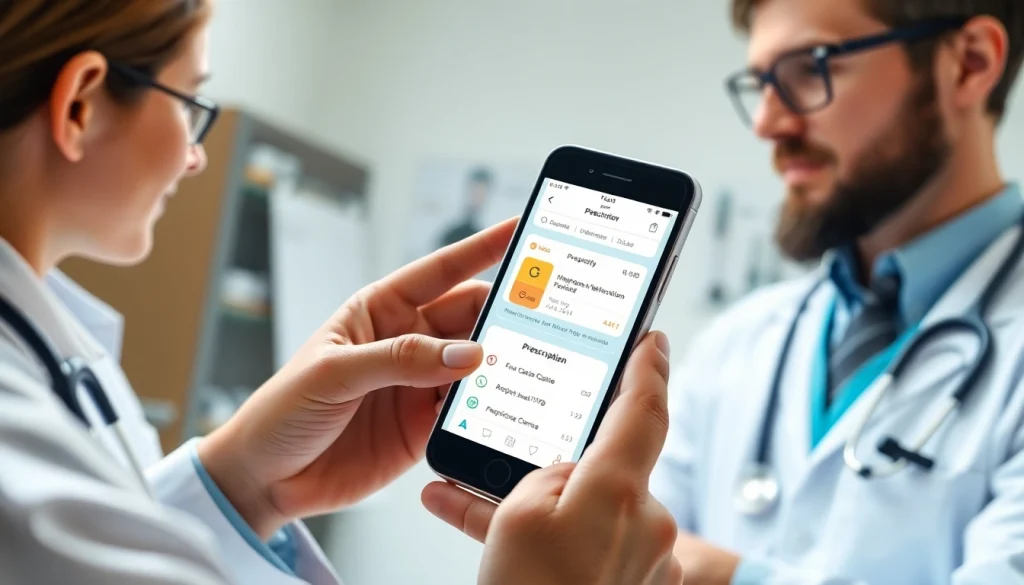Understanding the Importance of Top Rated Prescription Applications
Definition and Purpose of Prescription Applications
Prescription applications play a critical role in modern healthcare by facilitating the process of managing prescriptions for both patients and healthcare providers. These applications, often integrated into broader healthcare platforms, help in prescribing, tracking medications, and ensuring compliance through reminders and alerts. By streamlining communication between patients and pharmacies, they enhance the overall experience and efficiency of receiving medication.
Significance in Today’s Healthcare Landscape
In an era where digital health solutions are becoming indispensable, the significance of top rated prescription applications cannot be overstated. They not only improve patient outcomes by ensuring medications are taken as directed but also reduce the burden on healthcare providers. These applications are designed to simplify the entire prescription process, from the initial prescription to medication delivery, thus enhancing the overall efficiency of healthcare systems.
Overcoming Common Challenges in Prescription Management
Prescription management often faces challenges like medication errors, miscommunication between patients and healthcare providers, and adherence issues. Top rated prescription applications address these problems by providing clear communication channels, offering reminders, and allowing for easy access to medication information. Real-time updates ensure that all stakeholders are informed of any changes, which minimizes the risk of errors and improves the treatment experience for patients.
Key Features of Top Rated Prescription Applications
User Experience: Navigating the Interface
A user-friendly interface is crucial for the adoption of prescription applications. When the layout is intuitive, patients and healthcare professionals can easily navigate through features such as medication tracking, refill requests, and prescription history. Key functionalities like search filters, customizable notifications, and straightforward design help maintain engagement and ease of use.
Authentication and Privacy: Keeping Patient Data Secure
Given the sensitive nature of health information, security is paramount in the design of top rated prescription applications. These applications employ encryption protocols and strict authentication measures to protect patient data. Regular audits and adherence to healthcare regulations also ensure that data privacy is a principal focus, fostering trust between patients and providers.
Real-Time Updates and Notifications for Patients and Providers
Real-time updates play a vital role in the efficacy of prescription applications. Automated notifications about prescription status, refill reminders, and upcoming appointments keep both patients and providers informed. This proactive approach to communication aids in ensuring that patients adhere to their treatment plans and reduces the risk of missed doses.
Comparing Popular Top Rated Prescription Applications
Overview of Features and Functionalities
When comparing top rated prescription applications, it is essential to analyze their specific features and functionalities. Key attributes may include medication databases, interaction checkers, and integration with electronic health records (EHR). Understanding how these features align with the needs of both patients and healthcare providers can help in selecting the best application for practice.
User Reviews and Ratings: What Clinicians are Saying
User reviews and ratings provide valuable insights into the practical effectiveness of prescription applications. Feedback from healthcare professionals often highlights aspects like ease of use, reliability of the information provided, and overall satisfaction with the features. Analyzing these reviews can guide potential users in making informed choices about which applications to adopt.
Cost Considerations and Accessibility Options
Cost is a significant factor in the adoption of top rated prescription applications. Many of these applications offer different pricing models, including subscription-based, pay-per-use, or free versions with limited functionality. Additionally, accessibility options should be evaluated to ensure that all patients, regardless of technical skill or financial ability, can benefit from these tools.
Implementing Top Rated Prescription Applications in Your Practice
Steps to Get Started with Integration
Integrating top rated prescription applications into a healthcare practice requires careful planning and execution. The initial steps involve identifying the specific needs of the practice, selecting an appropriate application, and performing a detailed analysis of integration capabilities with existing systems. A well-defined implementation plan that includes timelines and milestones will help ensure successful adoption.
Training Staff: Ensuring Seamless Adoption
Staff training is critical in ensuring that all team members are comfortable and proficient in using the new technology. Comprehensive training programs should cover application functionalities, troubleshooting, and best practices to maximize the application’s potential. Regular refresher courses can also help maintain familiarity and encourage continued engagement.
Monitoring and Measuring Effectiveness Over Time
Once a prescription application is integrated, ongoing monitoring and assessment of its effectiveness are essential. This may include analyzing metrics such as reduced medication errors, improved adherence rates, and overall patient satisfaction. Gathering feedback regularly from both staff and patients can inform necessary adjustments, ensuring the application continues to meet evolving needs.
The Future of Top Rated Prescription Applications in Healthcare
Emerging Trends in Prescription Technology
The landscape of prescription technology is constantly evolving, with emerging trends such as artificial intelligence (AI), machine learning, and telemedicine integration shaping the future of patient care. These technologies are enhancing the ability to customize treatment plans and provide personalized medication management, making prescription applications even more valuable in the healthcare ecosystem.
Potential Regulatory Changes to Consider
As technology advances, so too do the regulations surrounding it. Healthcare providers must stay abreast of potential regulatory changes that may affect the use of prescription applications. Understanding compliance requirements will be essential in safeguarding patient data and ensuring that the application aligns with evolving healthcare standards.
Innovative Features on the Horizon
Looking ahead, the integration of advanced features like voice recognition, automated compliance checks, and predictive analytics is anticipated to enhance the functionality of top rated prescription applications. These innovations aim to further streamline processes, improve medication adherence, and ultimately lead to better health outcomes for patients.
